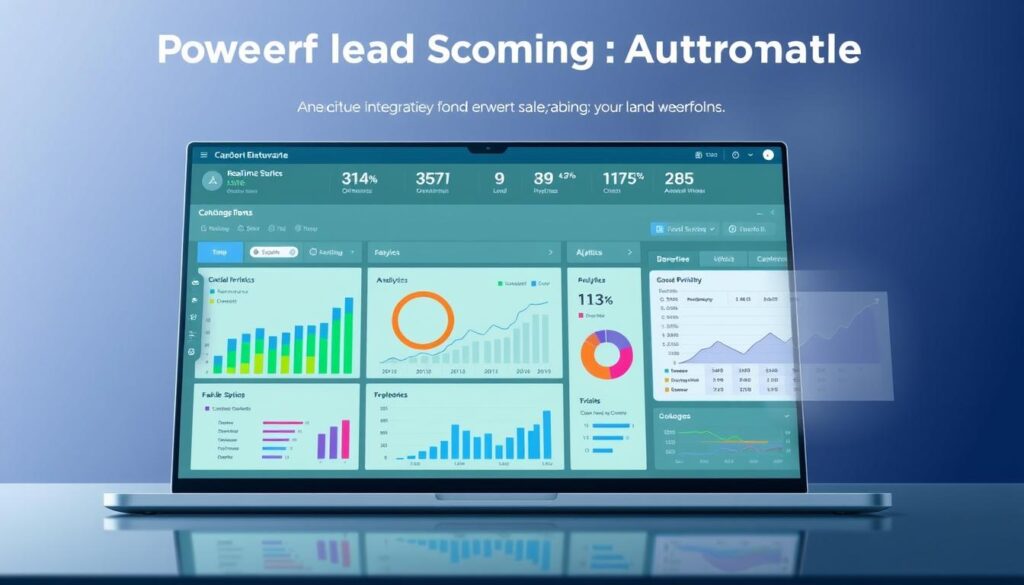In the race to stay ahead, using GTM lead scoring automation is key for businesses. It helps prioritize prospects who are more likely to buy. This method allows sales teams to target high-value leads, boosting their productivity significantly.
By getting rid of manual ranking, companies perform better. They use sophisticated lead scoring tools. These tools make the process smoother and improve how customers are chosen. As automation becomes more popular, including it in your sales plan is essential for success.
Key Takeaways
- GTM lead scoring automation boosts sales productivity.
- Automated lead scoring systems prioritize high-value leads.
- Advanced lead scoring tools enhance targeting accuracy.
- Eliminating manual ranking increases overall efficiency.
- Automation is key to optimizing lead qualification processes.
Understanding Lead Scoring in GTM
Lead scoring is vital in sales and marketing. It helps teams focus on important prospects. This makes outreach more effective.
What is Lead Scoring?
It ranks leads to see who might become customers. Numbers are given to leads based on actions and qualities. Lead scoring optimization lets companies pay more attention to promising leads. This increases chances of making a sale.
Importance of Lead Scoring
Lead scoring matters a lot today. Not all website visitors are ready to buy right away. As more leads come in, checking each one by hand doesn’t work well. A good lead scoring system shows who is more likely to purchase. This improves marketing efforts.
Key Metrics for Assessing Leads
A few important factors help in scoring leads. Things like where someone lives, their company, behavior, and how they interact with ads matter. Using these helps make a detailed lead profile. This improves the gtm lead management solution. It leads to more sales.
Benefits of Lead Scoring Automation
Lead scoring automation helps businesses improve their sales processes. It makes workflows smoother and lead management better. This leads to more sales and better performance.
Increased Efficiency in Sales Processes
Automation saves time for sales teams. They can focus more on follow-ups and closing deals. It cuts out manual scoring and data entry.
Salespeople can then focus on leads that are more likely to buy. They don’t waste time on leads that probably won’t convert.
Enhanced Lead Quality
With automated lead scoring, businesses can better assess their leads. The process highlights the most promising prospects using specific metrics. This means sales teams talk to leads more likely to make a purchase.
This higher lead quality increases the chances of successful sales.
Better Resource Allocation
Automated lead scoring helps in allocating resources more effectively. It shows which leads are more likely to convert. Teams can then adjust their sales strategies to match.
This method leads to better sales results and more efficient marketing.

Implementing GTM Lead Scoring Automation
To kick off GTM lead scoring automation, companies need a plan starting with learning about their customers. They must collect important data, create scoring rules, and analyze customer actions to set lead priorities. This process is key to guide through these steps.
Steps to Set Up Automation
Setting up an effective lead scoring system involves a few important steps:
- Figure out who your target customers are, looking at demographics and what they do.
- Gather data from different places like your website, emails, and social media.
- Decide how to score leads by their chance to become customers.
- Use tools that make tracking and scoring leads automatic.
- Keep an eye on how engaged leads are and tweak your scoring as needed.
Integrating with CRM Systems
Linking lead scoring automation with CRM software is key for handling data smoothly. A good integration gives salespeople a clear view of a lead’s activities and priorities. Keeping lead scoring tools up to date ensures precise tracking over time.
Tools for Lead Scoring Automation
Finding the right tools for lead scoring automation is vital for making the process more effective. There are many tools to choose from, so pick ones that match your goals. To understand how to make your automation work better, look into advanced lead scoring tools.
Customizing Your Lead Scoring Model
Customizing your lead scoring model is key to better gtm lead generation automation efforts. It makes sure that scores show the true value of leads, leading to more sales. When creating your model, consider what’s important for your business.
Factors to Consider
A few key elements help make your lead scoring work well. These elements include:
- Ideal Customer Profiles: Know what your best customers look like to find similar leads.
- Buying Triggers: Find out what makes potential customers decide to buy to engage them at the right time.
- Data Sources: Use different kinds of data to get a complete view of leads, making your model more accurate.
Thinking about these points helps make your scoring model fit well with your sales process, using your resources wisely.
Adjusting Scoring Based on Business Goals
Your scoring model needs to change as your business goals do. Check how your scoring affects lead quality and sales often. You might need to:
- Change scores based on what leads do.
- Add new metrics to stay up to date with the market.
- Make sure scores match your sales goals for a clear strategy.
This way, your lead scoring stays accurate, supporting your goals and improving your results.
Best Practices for Lead Scoring Automation
For the best results, using lead scoring automation requires careful work and team effort. It’s vital to follow proven methods to make the most of this tech in boosting sales. Here are some key steps to manage lead scores and strengthen teamwork between sales and marketing.
Regularly Review and Adjust Scores
It’s important to keep checking and tweaking lead scores to get it right. This means listening to sales team feedback, looking at how well leads turn into customers, and changing scores when needed. Doing reviews often helps stay up-to-date with market changes and ensures scores match what buyers do. This way, lead scoring automation can work much better.
Collaborate with Sales and Marketing Teams
Working together, sales and marketing teams can make lead scoring more effective. Having regular meetings helps both teams talk and share ideas about how good the leads are and how engaged buyers seem. This effort helps improve scoring models so they truly reflect what customers like now. When both teams are involved, lead scoring automation can really help increase sales and money made.
Common Challenges and Solutions
Implementing google tag manager lead scoring poses several hurdles. Addressing them promptly is key to success. Two main obstacles are the gap between sales and marketing and data quality issues. Solving these can boost the effectiveness of lead scoring efforts.
Misalignment Between Sales and Marketing
The gap between sales and marketing teams is a big issue. It can lead to confusion about what a good lead looks like. This often wastes resources and opportunities. To solve this, companies should have regular meetings and communication between the teams. This helps both teams agree on what makes a lead valuable. It also aids in creating strategies that improve conversion rates.
Data Quality Issues
Poor data quality is another big challenge in google tag manager lead scoring. Bad data can mess up the scoring process. It leads to wrong efforts and bad outcomes. High data quality needs routine checks and validations. Using tools that improve data and following best data practices can cut down errors. Continuous monitoring and improvement build a solid base for effective lead scoring.

Future Trends in Lead Scoring Automation
Lead scoring automation is changing fast, thanks to new tech. Companies are now using automated systems more often. These systems focus on AI and machine learning to improve. They make sure businesses can keep up with how consumers behave differently over time.
AI and Machine Learning in Lead Scoring
AI and machine learning are key parts of automated lead scoring. They use predictive modeling to look at old data in real time. This helps businesses adjust their scoring. With lots of data, these systems better find top-quality leads. This leads to more sales. Their ability to learn non-stop means they get better as trends and customer likes change.
The Rise of Predictive Lead Scoring
Predictive lead scoring is becoming essential for GTM (go-to-market) automation. It moves past old scoring ways by guessing which leads will likely turn into customers. This is based on data patterns. Thanks to analytics, companies focus on the most promising leads. This boosts conversion rates and efficiency. Predictive tools will greatly impact sales strategies in the future.
FAQ
What is GTM lead scoring automation?
GTM lead scoring automation uses advanced tech and AI to help rank leads. It helps sales teams focus on leads most likely to buy. This makes selling more efficient by targeting high-value leads.
How does lead scoring work?
Lead scoring assigns numbers to leads based on certain qualities and actions. This shows which leads are more likely to become customers. It helps sales and marketing teams know which leads to focus on.
What are the benefits of automating lead scoring?
Automated lead scoring makes sales more efficient and improves lead quality. It also makes better use of resources. Salespeople can spend more time closing deals instead of sorting through leads.
What steps are involved in setting up lead scoring automation?
To start lead scoring automation, companies need to define customer profiles and collect data. They must then set scoring rules. Watching and adjusting based on engagement is key for the best results.
What factors should be considered when customizing a lead scoring model?
Customizing a lead scoring model requires knowing your ideal customer and what makes them buy. It’s also important to use the right data sources. This helps align the model with your sales goals.
How often should lead scores be reviewed and adjusted?
Lead scores need frequent reviews to stay effective. This means listening to the sales team, looking at conversion rates, and keeping up with market changes. It helps ensure that scoring stays relevant.
What are the common challenges with lead scoring automation?
A big problem is when sales and marketing teams don’t work together well. Regular meetings and clear communication help keep lead quality and follow-up strategies aligned.
How do AI and machine learning enhance lead scoring?
AI and machine learning make lead scoring better by predicting future trends. They learn from past data to improve identifying and ranking leads. This boosts the accuracy and efficiency of lead scoring.



